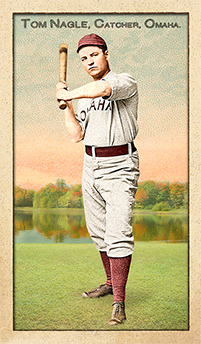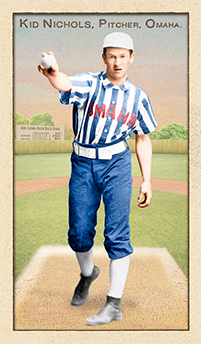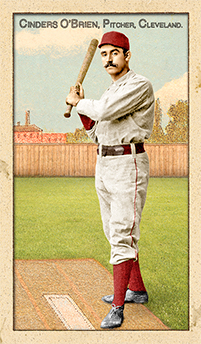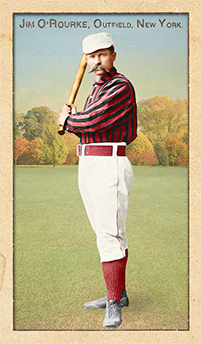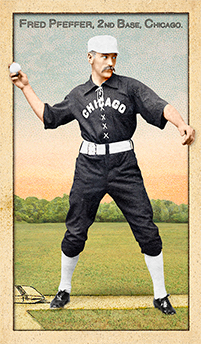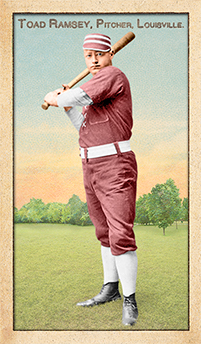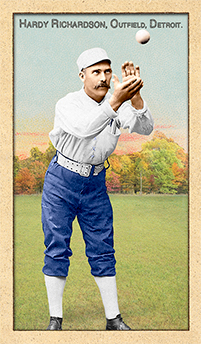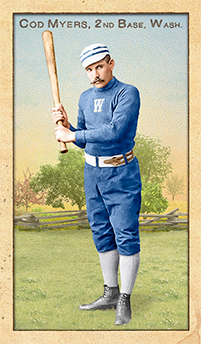
- Series: Beginnings: 1880's
- City: Washington, D.C.
- Team: Nationals
- League: National League
James Albert Myers (1863-1927) began in pro-ball for Muskegon and Winona in the Northwestern League before catching on with the Milwaukee Brewers of the Union Association, all in 1884. From there, Myers began a National League career, first with the Philadelphia Quakers and Kansas City Cowboys for a year each. He then played three years in Washington and three back in Philadelphia as the Quakers transitioned to Phillies, ending his baseball experience in 1891. The stocky second-baseman had a lifetime .246 average and never hit a home run. He was usually among the leaders in fielding chances and once led the league in errors.
- “Cod’s” best years as a regular were 1886 and ‘90, hitting a solid .277
- The latter year saw Myers swipe 44 bases and attain a .742 OPS
- Myer's uniform color in this card was changed from black to blue in August, 2017 to reflect recent reliable research conducted by Craig Brown and friends at Threads of Our Game. Six cards were previously released featuring a black uniform
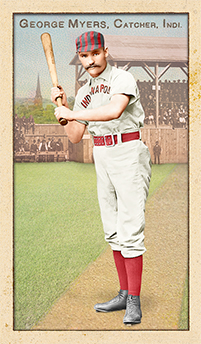
- Series: Beginnings: 1880's
- City: Indianapolis
- Team: Hoosiers (NL)
- League: National League
George D. Myers (1860-1926) was typical of the catchers of his day, a hard-working journeyman behind the plate and a weak hitter at it. His average over six years was a slim .203, but he was a steady backstop, valued by Buffalo and the Maroons/Hoosiers franchises. After 2 seasons with the Bisons, Myers moved to St. Louis in 1886 to the team that had started and ended the Union Association in ’84. Owner Henry Lucas had so stocked his Maroons as to make a mockery of competition. The league folded after a year and by 1886 John Brush bought the team and moved it to his Indianapolis stadium. Myers moved with the team and continued as the lead catcher, sharing duties with two others. Following his time in Indiana, Myers pursued minor league success with the Minneapolis Millers, then returned to his upstate New York roots with the Syracuse Stars and the Rochester Flour Cities through 1892.
- As a rookie in Buffalo, Myers cut his teeth under as fine a mentor as anyone in early baseball could hope for: “Orator Jim” O’Rourke who was in his final year as manager
- Although the Old Judge series features three known poses of George Myers, I could not find one of suitable quality for this project. This image is taken from an Old Judge proof taken at the same time as Meyers' other OJ images and may represent an as-of-yet undiscovered pose.
- Series: Beginnings: 1880's
- City: Omaha
- Team: Omahogs
- League: Western Association
Thomas Edward Nagle (1865-1946) was a catcher for the Chicago Colts of the NL over two seasons, 1890 and 1891. He had a promising debut in 1890, batting .271 with a .318 OBP, but slumped to .120 in only eight games in 1891. Nagle returned to the minors before leaving baseball in 1895.
- This Wisconsin native played in the Midwest throughout his time in baseball for Oshkosh, LaCrosse, and Omaha, ending his playing days with Dubuque in the Eastern Iowa League
- Despite his brief stint in Chicago, Nagle became part of one of our most enduring legacies: today’s Cubs enjoy the longest tenure in their original city in all of American professional sport
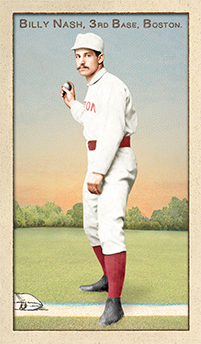
- Series: Beginnings: 1880's
- City: Boston
- Team: Beaneaters
- League: National League
William Mitchell Nash (1865-1929) made one invaluable contribution to baseball: he scouted & recruited Napoleon Lajoie, bringing him to the Philadelphia Phillies in 1896. By that time, Nash had mostly played out his ML career as a steady-hitting 3rd baseman for the Boston Beaneaters. He compiled a respectable .275 lifetime average and, in 1895, was declared by Sporting Life magazine “the best fielding third baseman in the League.” Traded for future Hall of Famer Billy Hamilton to the Phillies, Nash was player-manager when he found Lajoie who was pounding the ball for the Fall River Indians in the New England League.
- Nash broke into the majors with his hometown Richmond Virginians of the old AA in 1884 before finding a home wih the NL Beaneaters
- Best year was 1887: .295 AVG with 84 RBI
- Bill James ranks Nash 49th amongst third basemen all-time
- Sporting Life touted his $7500 compensation in ’91 as money well-spent
- Series: Beginnings: 1880's
- City: Omaha
- Team: Omahogs
- League: Western Association
- Hall: National Baseball Hall of Fame
Charles Augustus Nichols (1869-1953). A right-handed, switch-hitting pitcher, Nichols played 15 major league seasons for 3 different clubs. Nichols had 11 seasons with 20 Wins or more, 10 consecutively, 7 of which exceeded 30. He quit MLB for 2 years to own & pitch for a minor league team, with whom he won another 48 games.
- Youngest to 300 Wins (30 years)
- 5x NL pennant winner
- His 361 Wins ranks 7th all-time
- Nichols has five known poses in the Old Judge canon.
- Elected to Hall of Fame: 1949
- Series: Beginnings: 1880's
- City: Cleveland
- Team: Spiders
- League: National League
John F. O’Brien (1867-1892) pitched four seasons in the majors, changing leagues every year. He played in the AA, the NL, & the Players’ League – all for Cleveland teams, and moved to the Boston Reds in the AA for the 1891 season, his last due to his untimely death from pneumonia the next year.
- Had signed with Cincinnati to play in ’92 but passed away at his home in Troy, NY
- Was 18-13 for the pennant-winning Boston club in ‘91
- Series: Beginnings: 1880's
- City: Brooklyn
- Team: Bridegrooms
- League: American Association
William D. O’Brien (1863-1893) was an outfielder for the NY Metropolitans in his rookie year, 1887, and then played five years with the Brooklyn Bridegrooms. A speedster, O’Brien stole 321 bases in his illness-shortened career, hitting .282 with an OBP of .344. One of those with the distinction of playing for Brooklyn’s pennant winners in the AA in ’89 and NL in 1890.
- Ill when he reported for spring training in ’93, team raised money and sent him to CO to heal
- The weakened O’Brien succumbed to typhoid fever at the age of 29

- Series: Beginnings: 1880's
- City: Baltimore
- Team: Orioles
- League: American Association
John K. O'Brien (nee Bryne) (1860-1910) was a rare find for Billy Sharsig and his Athletics in 1881--a catcher who could hit. Jack joined the new franchise in its season in the Eastern Championship League and stayed on when the club joined the American Association the following year. By the '83 season, Jack would lead his team to the pennant, driving in a team-high 70 runs with a .290 average. O'Brien had entered baseball out west with the San Francisco-Reno team in the Pacific League as a raw 19 year old. He eventually played six of his eight major league seasons with the Athletics, for whom he always hit remarkably well for his position and era. His two years away from Philly with Brooklyn and Baltimore were struggles for him at the plate, but still exceeded the usual output for a catcher. Overall, Jack had a lifetime .266 BA in 555 games, driving in 308.
- Proving he wasn't quite done after his final year in Philadelphia, O'Brien signed on for the 1891 season with the St. Paul Apostles/Duluth Whalebacks of the Western Association where he hit .317 in 97 games
- In SF, Jack played with Sandy Nava, who would become the first Mexican-American in the major leagues with Providence and Baltimore
- Although the Old Judge series features nine known poses of Jack O'Brien, I could not find one of suitable quality for this project. This image is taken from an Old Judge proof taken at the same time as O'Brien's other OJ images and may represent an as-of-yet undiscovered pose.
- O'Brien’s uniform color on this card was changed in May, 2017 from black/red to blue/red to reflect recent reliable research by Craig Brown & friends at Threads of Our Game. Two cards had been previously released featuring a black uniform.

- Series: Beginnings: 1880's
- City: Omaha
- Team: Omahogs
- League: Western Association
Patrick H. O’Connell (1861-1943) had a very short-lived experience in the majors. He played mostly outfield during part of the 1886 season for the Baltimore Orioles of the American Association. He started 41 of his 42 games in the field, played one at first base and relieved for three innings in a game. His woeful batting (.181 average) was eclipsed by his even more inept play in the pastures as he committed 17 errors on 78 chances. By contrast, Jumbo Davis, the third baseman, handled 231 plays and muffed only 35 at the hot corner. O’Connell’s path crossed with Sandy Nava in his last appearance in the majors that season. Nava was the first known Mexican-American to play in the big leagues and was closing out what had been primarily a National League career.
Pat had broken in with Lawrence of the Eastern New England League in 1885. The Maine native continued briefly with Lawrence the next year before going back closer to home in Portland prior to making the jump to the AA later in ‘86. O’Connell found more playing time out west. He moved to Oshkosh in the Northwestern League for the ‘87 season and saw the most action of his pro career. He played regularly at first base and hit a resounding .354 in 116 games. From Wisconsin, Pat’s playing career declined quickly. He got into 84 games with the Omaha Omahogs in ‘88 and fewer than half that for two clubs the next year. After several years absence, Pat resurfaced in 1895 with the New Bedford Whalers of the New England League. At 34 he was the old man on the club.
- The Old Judge production department oftentimes misidentified Pat O'Connell on his cards as being a member of the Des Moines Prohibitionists of the Western League, occasionally listing his name as "Connell." A Peter J. Connell did play for Des Moines that year, and is one of 39 subjects who make a one pose appearance in the Old Judge cannon. (Mike Dorgan, by contrast, singularly leads the OJ cohort with 17 different poses.) Because of the confusion, this Pat O'Connell is oftentimes cited as PJ O'Connell. Such mix-ups are fairly common in the OJ series as the intrepid Old Judge crew sought to document as many players as possible in an era of shoddy record-keeping.
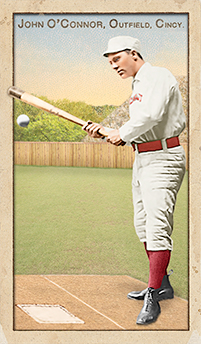
- Series: Beginnings: 1880's
- City: Cincinnati
- Team: Red Stockings (AA)
- League: American Association
John Joseph O’Connor (1866-1937) was as durable as they come. He holds the distinction, with a mere 28 others, of playing in four different decades in the majors. His durability was a product of his toughness. Despite the benign-sounding nickname of “Peach Pie,” O’Connor was known as one of the dirtiest players of his day and hard as nails. He excelled behind the plate, a position that devoured its occupants. With the Cleveland Spiders from 1892-98, O’Connor (also known as “Rowdy Jack”) hit .290+ four straight seasons. In his 21-year big league career, Jack hit a fine .263 He had started out with Cincinnati’s Red Stockings in 1887 and stayed in the Buckeye State with the Columbus Solons and Cleveland until he moved to St. Louis following the ‘98 campaign. He would move on to Pittsburgh and New York before landing back in St. Louis in 1904 where he remained through 1910.
Jack's waning days in St. Louis proved fateful for he and two of the game's all-time great hitters. Nap Lajoie and Ty Cobb were locked in a memorable duel for the batting title (and thus, the 1910 Chalmers Award) as the season wound down. O’Connor was the player/manager of the Browns when Lajoie’s Naps came to town for a season-ending double-header at Sportsman’s Park. History doesn’t record why O’Connor so strongly preferred Nap to win the title, but we might suppose Cobb wasn’t any more beloved in St. Louis than elsewhere. In any event, “Peach Pie” ordered his rookie third baseman Red Corriden to play back . . . way back, as in short left field. Lajoie proceeded to drop five bunts down the line, all for base hits. Lajoie reached base on his 6th at bat on a fielder's error, but O'Connor tried to bribe the official scorer to change the error to a hit, even offering to buy the woman a new wardrobe. The batting title and Chalmers Award went to Cobb despite the host’s accommodation. The difference in final average was minute, and the controversy inspired Chalmers to give both Lajoie and Cobb new cars. But the escapade cost O’Connor his job as league president Ban Johnson ordered him and Browns' owner Robert Hedges fired and banned. Decades later, research found Cobb had been double-credited with one day’s results. In 1981 Lajoie was declared the true winner of the batting title for 1910, by seven thousandths of a point. Rowdy Jack’s revenge….
- O'Connor's stunt got him blacklisted and unofficially banned from major league baseball for life
- At age 46, Jack returned to Cleveland’s Forest City club in 1912 for a last hurrah. No data survives for that team’s year but Baseball Reference records O’Connor managed the squad
- Series: Beginnings: 1880's
- City: Washington, D.C.
- Team: Nationals
- League: National League
- Hall: National Baseball Hall of Fame
“The Reverend” (1859-1935). O’Day was a pitcher & occasional position player over 7 ML seasons for 5 teams. Hank then umpired for 30 years, interrupting his tenure twice: to manage the Cincinnati Reds in 1912 and the Chicago Cubs in 1914.
- Member of ’89 Champion Giants
- Umpired 10 World Series
- Officiated Merkle’s Boner
- Called 4 no-hitters in 4 decades
- Only person to play, manage & umpire in NL
- Elected to Hall of Fame: 2013
- O'Day’s uniform color on this card was changed in August, 2017 from black to blue to reflect recent reliable research by Craig Brown & friends at Threads of Our Game. Nine cards were previously released featuring a black uniform.

- Series: Beginnings: 1880's
- City: St. Louis
- Team: Browns (AA)
- League: American League
- Hall: Canadian Baseball Hall of Fame
James Edward O’Neill (1858-1915) came out of Woodstock, Ontario to take the American Association by storm, becoming Canada’s Babe Ruth. Tip debuted with the NL’s Gothams in 1883 as a pitcher, receiving tepid reviews. He made a better impression on Charles Comiskey who signed him the next season in St. Louis to replace switch-pitching Tony Mullane. The following year theWoodstock Wonder came into his own at the plate. He became the Browns’ best hitter and led the team to four straight pennants, then falling second to Brooklyn in ‘89. Ever loyal to Comiskey, Tip followed his leader to the Players’ League Chicago Pirates, back to St. Louis in ‘91 and on to Cincinnati for his final campaign the next year. In his decade at the pinnacle of the game, O’Neill established one of the best hitting records of the 19th century: .326 BA, .458 slugging and a Triple Crown. He and Paul Hines remain the only such champions eligible for the Hall to be excluded (a fate shared with all the greats who played primarily in the AA, save for Bid McPhee).
- Tip’s excellence is commemorated north of the border with the Tip O’Neill Award given annually by the Canadian Baseball Hall of Fame
- U.S. Speaker of the House “Tip” O’Neill was nicknamed after James
- Elected to Canadian BB Hall of Fame: 1983
- Series: Beginnings: 1880's
- City: New York
- Team: Giants
- League: National League
- Hall: National Baseball Hall of Fame
James Henry O’Rourke (1850-1919) made the National League’s first base hit, and went on to a 21-year, Hall of Fame career. From 1876-92, only Cap Anson played in more games or got more hits. After leaving MLB for the minors, O’Rourke returned for his swan song with his pal John McGraw’s Giants, becoming the oldest player (at 54) to play in the NL and to get a hit.
- Played for 5 pennant winners and was NA HR champ in 1874-75
- One of only 29 to play in MLB in four decades
- Entered the HOF as one of the first 19th Century players to do so
- Elected to Hall of Fame: 1945
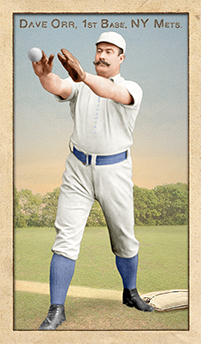
- Series: Beginnings: 1880's
- City: New York
- Team: Metropolitans
- League: American Association
David L. Orr (1859-1915). A 1st baseman for 5 teams over 7 major league seasons, Orr was one of the best hitters of the 1880s. Largely forgotten today, Orr may have made a case for the Hall of Fame were it not for a career-ending, paralyzing stroke suffered on the field in 1890. Dave’s .342 lifetime average is 11th all-time & in 4 of 7 seasons, his closest comp is Dan Brouthers.
Brouthers himself believed Orr was the greatest hitter of his time:
"The greatest hitter that ever played ball was old Dave Orr. He didn't care whether they were over the plate or not. If they were within reach of that long bat of his he would hit them out, and when he hit them there was no telling whether they would be found again or not. I have always held that Dave Orr was the strongest and best hitter that ever played ball." - Dan Brouthers, Sporting Life, 1894
- Won AA batting title: 1884
- Won AA RBI crown: 1884
- Lead AA in hits: 1884 & 1886
- Lead AA in triples: 1885 & 1886
- The team identification on this card was corrected in September, 2017, from Brooklyn to the NY Metropolitans. While Orr did play for Brooklyn in 1888, this photo was taken in 1887 when Orr was a member of the Mets and, indeed, he is wearing a Mets uniform. Nine cards were previously sold identifying Orr as a member of the Brooklyn club.
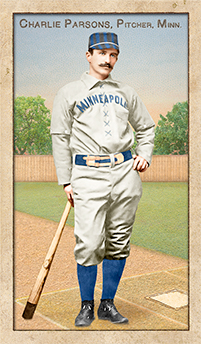
- Series: Beginnings: 1880's
- City: Minneapolis
- Team: Millers
- League: Western Association
Charles James Parsons (1863-1936) was a pitcher who got three try-outs with major league teams during a minor league career that spanned the latter half of the 1880s. He broke in with the Newark Domestics of the Eastern League in 1884 where, at twenty years old, he started two games, yielded just 3 earned runs in 15 innings and pitched to an 0-1 record. Charlie made an impression the following season for the Birmingham club of the Southern League, leading the team with a 10-13 record and an outstanding 1.48 ERA. On May 29, Parsons hurled the first no-hitter for those Barons, earning him a spot on the NL's Boston Beaneaters’ roster to begin the 1886 season. Assigned to pitch back-to-back games, Parsons lost both and was summarily sold to Rochester of the international Association, where he had an excellent year at 15-10 with a team-leading 1.12 ERA. Charlie’s sustained success in the minors earned him another spot in a major league rotation in 1887, this time with the New York Metropolitans of the American Association. In four starts, Parsons went 1-1 but gave up 17 earned runs (36 total runs for the error-prone Mets). By 1888, Charlie was suiting up for the Minneapolis Millers. Other than being immortalized in five known poses by a Goodwin photographer in his Millers uniform, Charlie started just one game in Minneapolis, surrendering two runs and finishing the game in a losing effort. In 1890 Parsons got one more shot in the majors with the Cleveland Spiders. Again, they only used him for two games and he lost his only decision.
- The Sporting News reported in its June 16, 1890 edition that Parsons had been signed by Jackson of the Tri-State League, but there is no evidence that he ever played professional baseball again
- Parsons was 25-24 with a 1.31 ERA in 51 minor league games, but just 1-4 with a 4.58 ERA in 8 major league games
- Charlie may have been a better hitter than pitcher. Although it’s a small sample, Charlie hit .333 (9 for 27) in his 8 ML games, knocking in two and stealing a bag for good measure
- Series: Beginnings: 1880's
- City: Chicago
- Team: White Stockings
- League: National League
Nathaniel Frederick Pfeffer (1860-1932). Nicknamed Dandelion, Pfeffer played for 7 teams over a good 16 year career. A good baserunner (at least 400 SBs) and league-average hitter (94 OPS+), Pfeffer was one of the best defensive second basemen of his era, dominating the defensive leaderboards for his position in the 1880s.
- 1st in PO at 2B from 1884-1891
- 1st in As at 2B: 1884-85, 1888-89
- 1st in DPs at 2B: 1884-1889, 1891
- 1st in RF at 2B: 1884-85, 1888-90
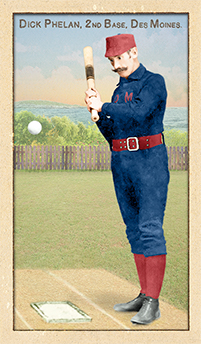
- Series: Beginnings: 1880's
- City: Des Moines
- Team: Prohibitionists
- League: Western Association
James Dickson Phelan (1854-1931) began playing professional baseball at age 28 with the Peoria Reds of the Northwestern League and went on to a lengthy career, taking him all the way to age 44 with the Southern League’s Dallas Steers. Early on Dick got his shot at the big leagues. He was brought up from Peoria to the Baltimore Monumentals for their year in the Union Association, 1884. The next year he played for the Buffalo Bisons and St. Louis Maroons of the NL. His ML batting average was .242 in 107 games as a second-baseman. The most games he played for one team was with the Memphis Browns in ’87 where he tore up the Southern League with a .370 average and stole 60 bases. He also played for Memphis when they were the Grays, Giants and the Fever Germs. The latter was Memphis’ identity in 1893 with the Southern League.
- It is presumed the team took its name in memory of the tragic outbreak of yellow fever in 1878, said to have begun “in the filthiest part of the filthiest city in America”
- That historic plague killed more in Memphis than the Chicago fire, San Francisco quake and Johnstown flood combined
- There may not be an I in team, but there are 4 of them in Prohibitionists
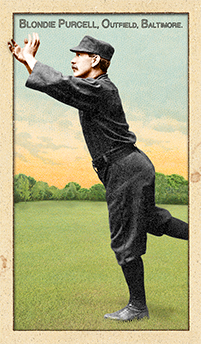
- Series: Beginnings: 1880's
- City: Baltimore
- Team: Orioles
- League: American Association
William Aloysius Purcell (1854-1912) ascended to the new “major leagues” in the early days of the NL as it was still in its formative stage. Playing OF for the Syracuse Stars, Purcell migrated with his team & the Buffalo Bisons out of the soon-to-perish International Association to join the new professional circuit. 1879 would be the first & last season for the Stars in MLB; and an incomplete year as the team folded on Sep 10. Nevertheless, Purcell would go on to a successful 12-year career. He finished ’79 with the Cincinnati Reds and would eventually play in Cleveland, Buffalo, Philadelphia, Boston and Baltimore. Purcell earned the distinction of being the first player in Philadelphia history to get a hit and score a run, in his first at-bat of the club’s inaugural 1883 season.
- Was once fined for destroying a baseball, which he had done to get a new ball into the game so that Pud Galvin could better throw his curve
- Late in his career, Purcell was recruited to manage the incorrigible Atlanta Atlantans of the Southern Assoc, a team that came to be dubbed “Purcell’s Plug-Uglies”
- .267 BA with 1,217 hits in 1,097 ML games

- Series: Beginnings: 1880's
- City: Des Moines
- Team: Prohibitionists
- League: Western Association
- Hall: Baseball Australia Hall of Fame
Joseph James Quinn (1864-1940) came a long way to play baseball for the Dubuque Rabbits. And it would be over a century until the next Aussie made the trip to the big leagues of America. Joe quickly advanced to that level with the Union Association’s St. Louis Maroons in 1884. Joe brought his working-class background to the ballpark and soon became one of the mouthpieces for players in an era when they were chattel. “Ol’ Reliable” was a leader in the Players’ League revolt in 1890, an interruption in Joe’s long National League career, primarily in Boston and St Louis. He had another memorable detour when called upon to take the “worst job in baseball” managing the doomed Cleveland Spiders in 1899. When owners shipped out Cy Young, Jesse Burkett, Bobby Wallace and others to their St. Louis Perfectos, Quinn was left with the unenviable task of shepherding the lousiest team in history to a 12-104 record. Even in defeat, Joe’s men followed him, a tribute to his character.
- In 1893, The Sporting News awarded Joe a gold watch as “the most popular player in baseball”
- Elected to Australian Baseball Hall of Fame: 2013
- Quinn's uniform color was changed in August, 2017, from black to blue to reflect recent reliable research by Craig Brown & Friends at Threads of Our Game. Six cards were previously released featuring a black uniform.
- Series: Beginnings: 1880's
- City: Boston
- Team: Beaneaters
- League: National League
- Hall: National Baseball Hall of Fame
Charles Gardner Radbourn (1854-1897). An elite pitcher for 5 teams over 12 seasons, Radbourn owns the single-season Wins record with either 59 or 60 (sources vary) in 1884 – the year in which he became baseball’s 2nd triple Crown winner with 441 Ks & a 1.38 ERA. In 1884, Radbourn started 40 of his team’s last 43 games and won 36 of them. In the 1884 World Series, Radbourn started and won all three games, giving up only 3 runs. Including the postseason, Old Hoss won 62-63 games in 1884 and threw over 700 innings.
- NL Triple Crown: 1884
- NL Wins champ: 1883, 1884
- 309 career Wins
- Pitched no-hitter: 1883
- Elected to Hall of Fame: 1939
- Series: Beginnings: 1880's
- City: Louisville
- Team: Colonels
- League: American Association
Thomas H. Ramsey (1864-1906). Toad pitched for the Louisville Colonels and St. Louis Browns from 1885-1890. In his rookie season, Ramsey only managed 66 complete games out of 67 starts! His 499 strikeouts that year still stand as the second-most all-time. His career flamed out after two stellar seasons, but Toad Ramsey left records that seem unthinkable today.
- Credited with inventing the knuckleball thanks to a severed tendon in his left index finger
- Died at age 41 of pneumonia in his hometown of Indianapolis
- Ramsey’s uniform color on this card was changed in February, 2017 from black to maroon to reflect recent reliable research by Craig Brown & friends at Threads of Our Game. Nine cards had been previously released featuring a black uniform.
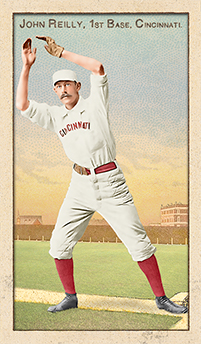
- Series: Beginnings: 1880's
- City: Cincinnati
- Team: Red Stockings (AA)
- League: American Association
John Good Reilly (1858-1937) was a one-man Big Red Machine long before the days of Bench, Morgan and Rose. When he was replaced at first base by Charles Comiskey in 1892, Long John held the Cincinnati Reds franchise records for singles, doubles, triples, home runs, runs scored, RBI, and games played. His decade with the Reds had seen Reilly consistently rank in the league's top ten in most offensive categories. In addition, his lean 6’3” frame made him a welcome first base target for his teammates. To this day, after more than a century of powerhouses in the Queen City, Reilly remains one of only four in team history to twice lead the league in HRs. In 2012 he was inducted into the Cincinnati Reds Hall of Fame, which according to the team’s website is the oldest continually operating team Hall of Fame.
- Reilly had been orphaned at age three when his father died in the Battle of Fort Donelson while serving as captain of a Union ironclad gunboat
- Long John grew up in Cincinnati as a professional artist until lured by his love of baseball. He was loyal to his hometown, retiring rather than moving to another club
- 69 career home runs were impressive for the era
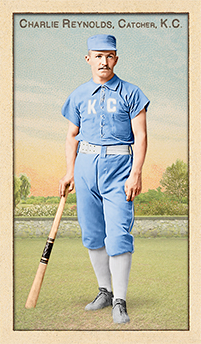
- Series: Beginnings: 1880's
- City: Kansas City
- Team: Blues (WA)
- League: Western Association
Charles Lawrence Reynolds (1865-1944) got a quick look in the majors in 1889. He was a catcher and debuted with the Kansas City Cowboys of the American Association on May 8. That day represented his career in KC. Charlie went one for four with an RBI. He played five innings and didn’t make an error. On May 22 the Brooklyn Bridegrooms purchased his contract and he moved east for a dozen games. He had nine hits in 43 ABs for a .214 average. Reynolds was charged with eight errors in 95 innings for a fielding percentage of .917. Perhaps it was this tendency toward miscues, coupled with an anemic batting record that curtailed his hopes of a career in the big leagues. Reynolds’ stint at the pinnacle of baseball came amid his college career at DePauw University in Greencastle, Indiana. His college production mirrored his MLB stats. His average was .217.
- Another DePauw alum became a true luminary of the game: Ford Frick went on to head the NL and serve as Commissioner of Baseball. The Hall of Fame in 1978 established the award in his honor that commemorates contributions in broadcasting
- Series: Beginnings: 1880's
- City: New York
- Team: Giants
- League: National League
Daniel Richardson (1863-1926) played 2B and SS for the Giants, Grooms, Senators, and Colonels over an 11 year span. His stints with the NY Giants included one year when the team played in the Player’s League (’90). He contributed to two Giant league championships in ’88 & ’89.
- During his one year with the Washington Senators, Richardson was player/manager
- Achieved a career BA of .254 and stole 225 bases
- Series: Beginnings: 1880's
- City: Detroit
- Team: Wolverines
- League: National League
Abram Harding Richardson (1855-1931). Primarily a 2nd baseman, Hardy played every position at one time or another, even going 3-0 as a pitcher. Playing for 6 different teams over 14 professional seasons, Hardy was an excellent hitter who retired with a .299 lifetime average. Hardy’s best season was 1890 when he hit .326, scored 126 Runs, knocked in 146 runs & stole 42 bases.
- Once hit a home run because the outfielder could not find the ball in the tall grass
- Bill James ranks him as the 39th best 2nd baseman all-time


